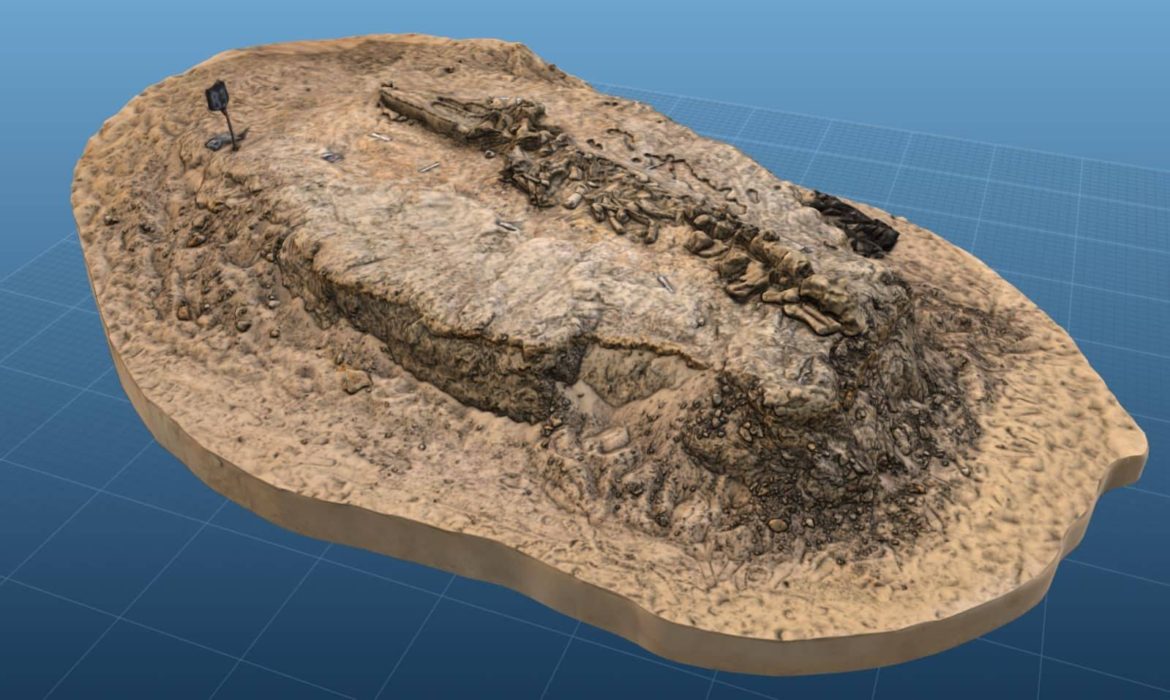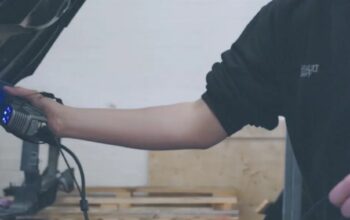This article was originally posted on engineering.com
How the Smithsonian & FARO® are Working to Scan Smithsonian Collections
3D scanning is a rapidly advancing technology that maps real-world objects onto 3D computer models. The applications of 3D scanning are numerous, and 3D scanning is seeing increasing adoption for applications such as quality control and assurance. But today, we’re going to step outside the realm of manufacturing to discuss how 3D scanning is used in the world of GLAM: Galleries, Libraries, Archives, and Museums.
 Vince Rossi uses a FARO laser arm scanner to capture a whale skeleton for research.
Vince Rossi uses a FARO laser arm scanner to capture a whale skeleton for research.
The Smithsonian’s Digitization Program Office
The Smithsonian Institution comprises a collection of nineteen museums, nine research centers, and one National Zoo spread across the United States. The Smithsonian has a vast collection of objects, artifacts, and specimens—about 155 million in all. These objects include everything from insects to airplanes, an immense record of science, history, art, nature, and everything in between.
The Smithsonian’s Digitization Program Office is on a mission to capture these objects with 3D scanning.
“The goal of our group is really to think about how we can use 3D measurement tools and 3D scanning tools to either solve a research problem or support access,” said Vincent Rossi, Senior 3D Program Officer with the Digitization Program Office. “We work with all nineteen museums and nine research centers. We’re a five-person team and we operate kind of like a little startup within the Smithsonian universe.”
The Smithsonian’s raison d’être, according to the Institution itself, is to increase and diffuse knowledge. There are many ways the Digitization Program Office uses 3D scanning to achieve this goal. Perhaps the most obvious is to record the Smithsonian’s objects for posterity and to make them more accessible to the world. With 155 million objects in the collection, less than one percent can ever be physically displayed. By scanning these objects and making them available, many more people can gain access to the collection.
But the Digitization Program Office wants to go further than just scanning an object and sharing the model. They want to pair the models with the curators and researchers who study them, to imbue the models with stories that connect them to the real world.
“To use that 3D object as a tool for learning and discovery, that’s the real goal of our office and the Smithsonian,” said Rossi.
Engare Sero and Cerro Ballena
 3D model of fossil whale MPC 675 from Cerro Ballena. (Image courtesy of Smithsonian.).
3D model of fossil whale MPC 675 from Cerro Ballena. (Image courtesy of Smithsonian.).
The Digitization Program Office is also using 3D scanning to assist in research at the Smithsonian.
“Real research happens here. It’s a research institution. And a lot of the exhibits that you see on display are products of that research,” Rossi said. “So, another thing we do is use 3D scanning tools to support research at the Smithsonian and around the world.”
In 2010, Rossi and his team traveled to Tanzania to document an early human footprint site called Engare Sero. In those days, the Digitalization Program Office was using slightly lower tech: they took 1200 images using the 21.1 megapixel Canon EOS 5D Mark II. Using photogrammetry software originally meant for the Australian mining industry, Rossi and the team generated point clouds of three early human footprints. In the time since, they’ve been able to reprocess the data to produce even higher resolution meshes.

 Top and side views of Engare Sero Footprint H12 from 2010. (Image courtesy of Smithsonian.)
Top and side views of Engare Sero Footprint H12 from 2010. (Image courtesy of Smithsonian.)
The team’s second international trip took them to the Atacama Desert in Chile, to a site called Cerro Ballena. Construction workers building a highway had discovered the bones of dozens of whales, fossils which were determined to be 5 million years old. Road construction was paused, and the Digitization Program Office was called in to preserve the site in 3D.
“That contextual information, about how these fossils were arranged in the earth, was important for the researcher,” Rossi explained. “And the normal method of documentation would be a researcher drawing a meter-by-meter string line over the ground, and then sketching the approximate location of each fossil on paper. And of course there would be photographs as well. But with the 3D data we were able to get this snapshot of this research moment in time at a high degree of accuracy and incredible resolution.”
The team used the FARO ScanArm and FARO Focus Laser Scanner to document the site. They scrambled to fashion a makeshift base for the arm out of concrete and plywood, as it was designed for use in a lab, not in the desert. Their ad hoc solution worked. All told, the project was an interesting learning experience, according to Rossi.
“At the time we were new users. That was the first time we had used the laser arm scanner. We did a one-to-one resolution scan on a 30-foot fossil whale, which, with more experience behind us now, is kind of insane,” he said.
Now, the FARO ScanArm has become an indispensable tool for the Digitization Program Office. “The FaroArm® scanner is a tool to get high resolution, high accuracy geometry. And it’s mobile, so we’ve travelled around the world with it,” Rossi said.
The Challenges of 3D Scanning
 The new 8-Axis (pictured left) and the Digitization Program Office scanning an artifact (pictured right).
The new 8-Axis (pictured left) and the Digitization Program Office scanning an artifact (pictured right).
3D scanning poses unique challenges to those in the GLAM community. One is a problem faced by all who 3D scan — certain materials scan better than others, and there’s a lot of diversity in the 155 million objects at the Smithsonian.
“When scanning a surface that’s highly reflective, that can be a challenge for a lot of different scanners,” Rossi explained. “Objects that are translucent or transparent are also challenging. And also just size. If you’re scanning a bumblebee, that’s one tool and software, and if you’re scanning an aircraft, that’s an entirely different set of tools.”
But their heterogeneity is not the biggest issue with those 155 million objects. An even bigger problem is the sheer amount of time it would take to scan them all—especially with a five-person team.
“For every hour in the field, we can easily spend eight hours processing,” Rossi said. “Anything that speeds up capture and minimizes post processing is what we think about everyday.”
The Digitization Program Office is particularly excited about the new 8-axis FAROArm, a 3D scanner with a rotating platform component that speeds up data capture. The Digitization Program Office had a chance to test the 8-axis scanner and will soon have one of their own. The rotational stand not only helps the rate of data capture but it also helps in another important aspect of GLAM scanning: object handling.
“Any scanning solution that minimizes object handling, that’s a really important consideration,” said Rossi. “It’s actually the most critical thing, object handling. Because if you mishandle an object that’s one-of-a-kind, that’s Neil Armstrong’s glove, if something were to happen to that—it’d be really bad. So minimizing object handling is another really important consideration and a priority and a huge help to our team.”
Next Steps for the Digitization Program Office
When not scanning the Smithsonian’s gigantic collection, the Digitization Program Office is working diligently to create 3D tools and standards that can help make their work easier and more accessible. They’re currently developing an opensource tool that will automate some of the post-processing steps involved in 3D data capture.
“Thinking about how we can improve the processing time is really key for our team and it’s important for us thinking about scaling up. How do we make a dent in scanning the massive collection that the Smithsonian holds? If we do that with manual methods that are in place now, it’s certainly amazing job security, but we wouldn’t make a dent with manual methods.”
The team is also working on an extension to the glTF file format to add support for 3D annotations. This serves the Digitization Program Office’s vision of not just sharing 3D models, but telling stories and educating viewers. If all goes well, the Smithsonian extension will be adopted by multiple vendors and potentially incorporated into the glTF format.
Whatever steps the Digitization Program Office takes in the future, they’ll do so only with the help of altruistic partners. About 60 percent of the Smithsonian’s budget is funded by the federal government, and the difference is made up through fundraising and partnerships with companies like FARO.
“We have a really great partnership with FARO,” Rossi said. “And those partnerships get us access to technology like laser scanners that we might not be able to afford with the Smithsonian’s budget.”
To view any of the 3D models discussed in this article (and a lot more) visit 3d.si.edu.
FARO Technologies had no editorial input to this post. All opinions are mine. — Michael Alba









